Award-winning Genesis Gets New Beginning
Filed under: Equinox, Autos
By John Gilbert
Hyundai faced a pretty tall order when it revised its Genesis sedan for its second generation in the U.S. sports-luxury sedan class. After all, when the first Genesis hit these shores as a 2009 model, it won North American Car of the Year honors, and its engine was named to the Ward’s Top Ten engine list.
It was a bit sporty, but mostly a venture by the South Korean manufacturer to prove it could enter the luxury segment with a stately, if conservative, vehicle, coming out after the breakthrough midsize Sonata had startled the auto world by being distinctly not conservative.
The new Genesis, coming out as a 2015 model, is a stunning over-achiever in both technology and appearance and it seems that Hyundai decided to make its upscale sedan the company’s new icon — safely below the super-luxury Equus but a large stride ahead of the current Sonata. As an intriguing footnote, Hyundai came right back to introduce an all-new Sonata, which is also much refined, and resembles the new Genesis more than the current Sonata. Maybe Hyundai intends to have two halo cars.
If looks matter most in luring customers away from the Mercedes-BMW-Audi German trio and Japan’s Lexus, the Genesis moves boldly from functional to flashy by comparison. In first examination, I couldn’t forget that when Hyundai affiliate Kia hired Peter Schreyer away from Audi to coordinate some fantastic designs, such as the last Kia Optima, parent Hyundai suggested that Schreyer take over as design chief for the whole operation, meaning both brands. If that makes it less of a coincidence than Hyundai might suggest, the Genesis grille is a stylish new shape, sort of a wide shield that bears a resemblance to the front-dominating grille on every Audi sedan.
The difference is enough, of course, but it wears well on the Genesis, tapering up from the bottom to catch the contour that comes off the headlights in a stylish juncture that makes the entire front end seem wide and impressive. From the side, the Genesis sweeps back along an upper character line that runs just under the window sills and incorporates the door handles.
The roofline tapers down and then kinks forward, not unlike the BMW luxury sedans, and at the rear, well, it’s back to resembling the Audi sedans the way the horizontal taillights catch that character line and send it across under an integrated spoiler.
“We pulled the cabin rearward,” said John Krsteski, design manager of the Genesis. “The car is wider, too, and has a striking character feature. The grille is shaped like a winged hexagon.”
A hexagon, of course, has six sides, and if you count the gentle curve at the top of either side of the grille as two, then it could transform itself from a winged four-sided opening to a winged six-sided thing. “I can’t tell you how many sketches we did on the rear end,” Krsteski added. “We pulled the rear corners back and we did hundreds of different sketches on the taillights.”
Back when the new Genesis was introduced at The Sanctuary in Phoenix, it was made clear that Hyundai proved it could build comfortable and smooth luxury sedans with the first Genesis and the Equus, but Hyundai officials also acknowledged that the company still had what it calls a “perception gap” that separates it from BMW, Mercedes or Audi. As for Lexus, Hyundai’s luxury sedans started being sold cheaper than Toyota’s prize upscale sedans. The new models will sell for about the same price as the comparable Lexus cars, and is aimed at closing the perception gap as quickly as possible by offering more value for the money. It may take longer for the Equus to close the premium gap on the BMW 7-Series, Mercedes S-Class and Audi A8, so Hyundai is aiming to do it with the Genesis, aimed at the BMW 5-Series, Mercedes E-Class, and Audi A6.
Hyundai officials stress that it isn’t something that can simply be achieved, but must be engineered into the new car. With that, the new Genesis bristles with technology and refinement when compared to the award-winning current car. It rides on a new platform, nade significantly more rigid for handling and crash-performance with some aluminum and an increased amount of over 51 percent high-grade steel. At that, the body is only 0.2-inches longer overall at 196.5 inches, on a wheelbase that measures 3 inches longer at 118.5. At 74.4 inches wide and 58.3 inches tall, it is both wider and lower. That means shortening the overhangs front and rear by pushing the four wheels out closer to the extremities and stretching that sleek sheetmetal to cover it.
Inside, all the goodies now expected of luxury sedans abound, such as lane-departure warning, lane assist to keep you inside those lines, Google connectivity, and an impressive all-wheel-drive system called HTRAC. There are also all sorts of settings for sport, eco, snow, and normal — virtually any situation a driver can encounter. Improved seats and attention to detail on all the soft-touch dashboard and door panel material.
Engines are the revised 3.8-liter V6 Lambda, or the upgraded 5.0-liter Tau V8, which is enlarged as the replacement for the award-winning 4.6. The Tau V8 has 420 horsepower through its driven rear axle, while the Lambda V6 delivers 311 horsepower and can run the AWD system.
The potency of the aluminum V8, with direct injection and dual variable valve-timing and those 420 horses, will be the favorite of the power-hungry or the rear-drive traditionalists. And it is an impressive package, with its homebuilt 8-speed automatic transmission, at $51,509. It rises to $55,700 by adding the Ultimate package, which gives you a premium navigation system with a 9.2-inch high-def display, a 17-speaker Lexicon audio, continuously adjusting damping control, heads-up display, and dual vent control with CO2 sensors, plus a power trunk lid.
Now, the power trunk lid is something I need to test more. Ford brought out the idea on the 2014 Escape, where someone carrying arms-ful of groceries can, with the key fob still in pocket or purse, can sweep a foot under the rear bumper and the tailgate magically opens. On the new Genesis, you merely have to be standing by the rear end of the car with the fob in your pocket and the trunklid pops open. I suggested that might be a problem if someone was merely hanging out back there and the trunk kept opening.
For significantly less money, starting under $40,000, the Genesis with the V6 and all-wheel drive will be the clear choice for those living in the winter-driving belt. It also runs through the 8-speed automatic, and its HTRAC was demonstrated graphically out in the desert, where it was placed on a portable set of rollers under three of the tires, meaning traction could only get through to the fourth.
The system, we’re told, uses electro-mechanical control of its actuator, a worm-shaft with its own clutch to control torque. The system monitors all four wheels, of course, and for the purpose of our demonstration, on startup the right front, and both rears, might have spun merrily on their rollers, but with HTRAC, the torque is sent to the left front, the only wheel with traction, and the Genesis launches straight ahead.
The HTRAC directs a 40/60 front/rear split in normal circumstances, but can adjust for up to a 90/10 split in slippery conditions, or switch 100 percent of the power to the rear wheels during Eco highway cruising. The Intelligent Drive system on Normal sets the throttle and shift schedule for decent response and efficiency for average driving. In Sport, the system adjusts to sportier response and shift points. In Snow, throttle response is reduced to lessen the risk of wheelspin on starting up.
The sophisticated safety system includes emergency braking aids that apply full braking force if a crash is detected as imminent from 5-50 mph. From 50-112, you get a collision warning and partial braking force. It’s the same in revers for smart cruise, which paces the car ahead and will even make a complete stop if the car ahead stops in your path — then it will start up again when the car ahead starts, and regain your interval and pace.
Hyundai is calling the new design of the Genesis “Fluidic Sculpture 2.0” and indicates it will establish guidelines for future Hyundai vehicles. With the Sonata following the look, that plan is evident. On the Sonata, it may look more conservative, but on the Genesis, it is luxury with a flair, turning a nice, conservative design into something far more dynamic.
New Challenger Power: Excessively Sublime
Filed under: Equinox, Autos
By John Gilbert
If you can’t tell by the “Sublime” paint job that is close to glow-in-the-dark green, then the little Superbee medallion on both flanks of the 2015 Dodge Challenger should put you on full alert: The Ponycar War just escalated.
The big news in the hot, fun, halo performance-car segment is that the new Mustang will be thoroughly restyled for 2015 with independent rear suspension and a high-tech EcoBoost engine option, plus a Shelby GT500 model with 500 horsepower, while Chevrolet is countering by blessing the new Camaro with a Corvette engine option with 505 horsepower as the $75,000 Z-28. What could Dodge do with its 2015 Challenger to avoid being left behind — literally and figuratively?
Plenty, as it turns out. Faced with higher stakes in the three-ponycar battle, which began back around 1970 when they were the stalwart performers in the Trans-Am road-racing series, the rejuvenated Chrysler group dedicated Dodge as its high-performance weapon, and Dodge engineers came through with bone-jarring power combined with clever technology to send the new Challenger off to battle well-armed. Speaking of the small group called “standard specialty segment,” and which I call future-retro ponycars, many might think it consists only of expensive toys, with rear-wheel drive that negates a lot of winter-driving use.
But consider that the segment sold 430,000 units last year, which is 10 percent more than in 2009, and it is projected to grow 42 percent in the next five years. The Challenger was reintroduced five years ago, and while its sales doubled from 2009-2013, it set a sales record last year, when it should have been fading as a fifth year vehicle. The new car should render all current records obsolete.
To the uninitiated, the new Challenger won’t look all that different from the current Challenger. But to the discerning eye, the revised grille and other subtle touches are remindful of the 1971 Challenger, but even at the height of muscle cars, no ponycar — and no hot sedan, for that matter — has had what lurks under the hood of the new Challenger. For openers, the Challenger starts with the very competent 3.6-liter V6, and steps up to the 5.7-liter Hemi V8, which takes the V6‘s 305 horsepower up to 375, coupled with 410 foot-pounds of torque in a stick-shift R/T version.
Leaping above the R/T is the R/T Plus, with a 6.4-liter Scat Pack model, which has 485 horsepower and 475 foot-pounds of torque through a six-speed manual or eight-speed automatic. That’s the one with the Superbee festooned to the sides, that cartoon symbol of Dodge and Plymouth power from over 40 years ago. Ah, but that’s not all. Remember, the new Mustang’s Shelby version is rumored to be about 500 horsepower, and Motor Trend did a cover story on the Z-28 Camaro, claiming 505 horsepower and 481 foot-pounds of torque. Dodge’s SRT — for Street and Racing Technology — high-performance team had a loftier objective: 700 horsepower.
They made it, with some to spare. They came up with a 6.2-liter Hemi V8, reinforced every component, and chose not to use direct injection, because forced injection was determined to be better for this project. They fitted a twin-screw supercharger on top to blast an air-fuel mixture into the cylinders and ultimately achieveed an incredible 707 horsepower, with 650 foot-pounds of torque. That engine comes in the top-performing package, which will be called the Hellcat, and we can expect it to rip off 0-60 times of around 4 seconds. Read more



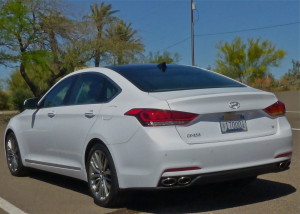
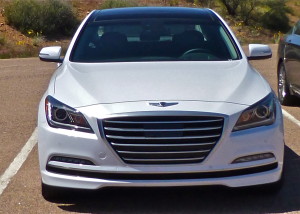
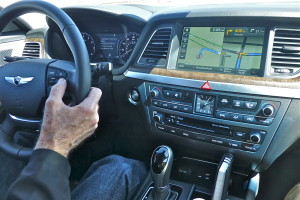
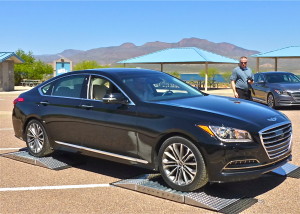
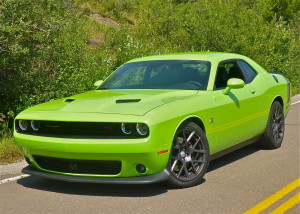
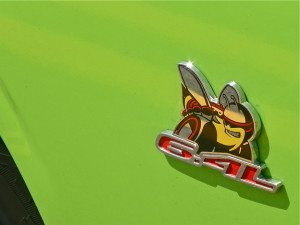
 John Gilbert is a lifetime Minnesotan and career journalist, specializing in cars and sports during and since spending 30 years at the Minneapolis Tribune, now the Star Tribune. More recently, he has continued translating the high-tech world of autos and sharing his passionate insights as a freelance writer/photographer/broadcaster. A member of the prestigious North American Car and Truck of the Year jury since 1993. John can be heard Monday-Friday from 9-11am on 610 KDAL(www.kdal610.com) on the "John Gilbert Show," and writes a column in the Duluth Reader.
John Gilbert is a lifetime Minnesotan and career journalist, specializing in cars and sports during and since spending 30 years at the Minneapolis Tribune, now the Star Tribune. More recently, he has continued translating the high-tech world of autos and sharing his passionate insights as a freelance writer/photographer/broadcaster. A member of the prestigious North American Car and Truck of the Year jury since 1993. John can be heard Monday-Friday from 9-11am on 610 KDAL(www.kdal610.com) on the "John Gilbert Show," and writes a column in the Duluth Reader.